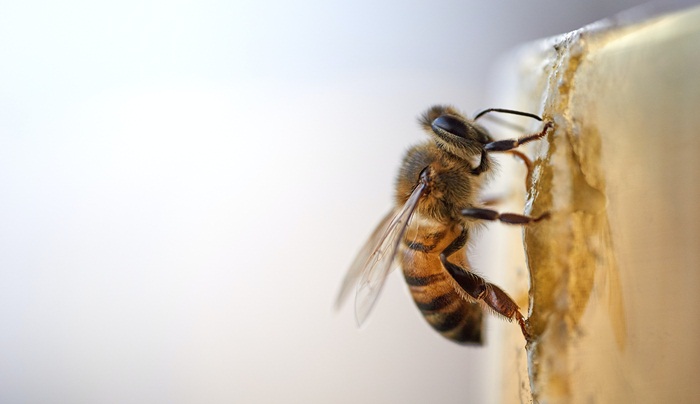Without honey bees our gardens would be bare, our plates empty, and the ecological balance completely upset.
DR SITAVI YATHIENDER
An ecosystem is the structural and functional unit of the environment where living organisms interact with non-living components and maintain a balance. Anthropogenic activities like industrialization, urbanisation, pollution, agricultural intensification, deforestation, and soil erosion have played havoc to the rich biodiversity of our country. Flora and fauna play a significant role in our lives and we have to be sensitised to protect their habitats. Keystone species play a specific role in an ecosystem and help in its sustenance. Human interference on many keystone species are causing damage to the environment and also increasing their risk of becoming endangered or extinct. Honey bees existence contribute to the natural ecosystem functions, as they are an important keystone species for the pollination of crops.
The honeybees, are insects of an order Hymenoptera, which also includes wasps and ants. The anatomy and morphology of the honey bee helps it to co-exist and lead a symbiotic relationship with other organisms on earth. Honey bees possess several salient features which make them good pollinators. Foraging worker bees are always on the hunt for nectar from flowers. Their proboscis or tongue is long and helps them reach the nectar in the center of the flower. They collect nectar from various flowers and process it into honey by evaporating excess water, transforming it into a viscous, concentrated energy source. Additionally, they add valuable enzymes to enable long-term storage for the sustenance of the colony. During the honey flow season, they store the excess honey in special wax-capped cells in the honey comb.
While collecting the nectar the bees are providing a great service to the plant as they brush against the pollen. Their furry legs and bodies are suitable for brushing off the pollen, as they visit other flowers aiding in pollination. Pollination is the process by which the pollen grains from the anther of the stamen (male reproductive organ of the flower) reach the stigma of the ovary. Honey bees help in the pollination process while collecting nectar for honey. Nectar and honey are good substitutes for sugar and since nectar is directly got from plants vegans prefer it to honey. Apart from providing honey, royal jelly and pollen they also produce beeswax, propolis and venom.
India is gifted with a rich biodiversity of both solitary and social bees like honey bees having several species under the genus Apis, indigenous to India. About 80% or more of the crop plants depend on insect pollination and native bees are efficient pollinators providing a stable ecosystem enabling plants to produce seeds and fruits.
India is home to three species of Apis under family Apidae
• The rock bee (Apis dorsata).
• The Indian hive bee, (Apis cerana indica ).
• The little bee, (Apis florea).
Unfortunately honey bees are currently on decline and we are reminded of the Albert Einstein’s quote “If the bee disappeared off the face of the Earth, man would only have four years left to live.” In addition to providing valuable commercially important hive products bees ensure food security and to conserve the biodiversity and ecosystem.
They contribute to the rich biodiversity and are linked both directly and indirectly in the food chain. But as vectors of pollination, they contribute to the reproductive cycle of many plants, which provide food for other organisms. Without honey bees our gardens would be bare, our plates empty and the ecological balance completely upset.
They provide habitat to a number of organisms. Street trees and trees in forest are visited by honey bees, and their role as pollinators is vital to the growth of these trees. If Bees disappear, small organisms who depend on these trees for food and shelter would also disappear along with.
Bees procure honey and store it to feed their colonies during the cold winter months. Like humans a number of organisms also raid the bee hives for honey and also feed on the bee larvae. Bees are prey to a number of organisms who feed on them and they are themselves primary consumers feeding on the nectar of the flowers thus forming a part of the food chain.
Honey bees which form a crucial part for food production, human livelihood and biodiversity are under great threat especially by humans due to various factors. Decline in numbers is due to, increase in temperature associated with climate changes, encroachment of forests, industrialization, negative agricultural practices like monoculture and excessive use of pesticides all contribute to the diminishing numbers of honey bees in nature. Infestation by disease causing organisms and predators , habitat loss , competition among native and introduced species, improper disposal of waste contaminating the environment are all adding to the decline in honey bee numbers.
Researches also report that concrete and glass buildings increase the temperature, alteration in the local climate, hostile treatment and conflict with humans in urban areas, pollution and excessive population all are silent contributors that bring down the population of honey bees.
Understanding how bees react to anthropogenic stressors , public awareness, providing honey bee-friendly habitat in gardens, growing bee friendly native plants and colourful flowers which attract the bees more than hybrid varieties , use of bee box in consultation with a beekeeper are some of the ways we can adopt to be bee friendly.
Existing green spaces and trees have to be preserved and we need to create habitats to save these industrious bees. Efficient long term strategies are needed to reduce the decline of honey bee populations.
Dr Sitavi Yathiender is the Head of the Departments of Zoology & Genetics at Jyoti Nivas College, Bangalore.
∎